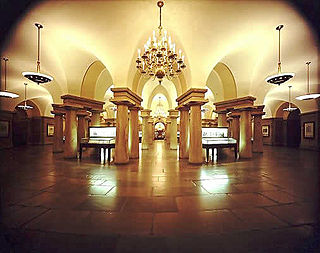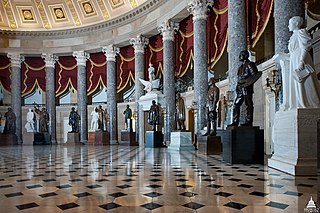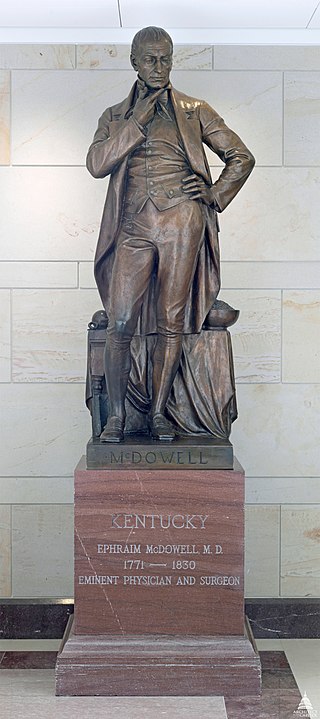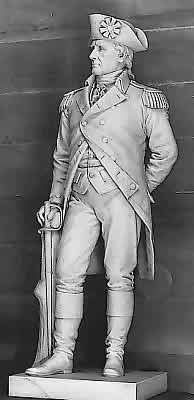
The Statue of Freedom, also known as Armed Freedom or simply Freedom, is a bronze statue designed by Thomas Crawford that, since 1863, has crowned the United States Capitol dome. Originally named Freedom Triumphant in War and Peace, a U.S. government publication now states that the statue "is officially known as the Statue of Freedom." The statue depicts a female figure bearing a military helmet and holding a sheathed sword in her right hand and a laurel wreath and shield in her left.

The National Statuary Hall is a chamber in the United States Capitol devoted to sculptures of prominent Americans. The hall, also known as the Old Hall of the House, is a large, two-story, semicircular room with a second story gallery along the curved perimeter. It is located immediately south of the Rotunda. The meeting place of the U.S. House of Representatives for nearly 50 years (1807–1857), after a few years of disuse it was repurposed as a statuary hall in 1864; this is when the National Statuary Hall Collection was established. By 1933, the collection had outgrown this single room, and a number of statues are placed elsewhere within the Capitol.

Percy Bryant Baker better known as Bryant Baker, was a British-born American sculptor. He sculpted a number of busts of famous Americans. In 1910, Queen Alexandra of the United Kingdom commissioned him to create a bust of King Edward VII.

The United States Capitol Visitor Center (CVC) is a large underground addition to the United States Capitol complex which serves as a gathering point for up to 4,000 tourists and an expansion space for the U.S. Congress. Opened in 2008, it is located on 1st Street East below the landscaped tree-shaded grounds of the East Front of the Capitol and included the development of the surface plaza. Additional, transparent skylights also punctuate the surface plaza to allow light into the center. The complex contains 580,000 square feet (54,000 m2) of space below ground on three levels. The overall project's budget was $621 million dollars.

The United States Capitol crypt is the large circular room filled with forty neoclassical Doric columns directly beneath the United States Capitol rotunda. It was built originally to support the rotunda as well as offer an entrance to Washington's Tomb. It currently serves as a museum and a repository for thirteen statues of the National Statuary Hall Collection.

William Henry Harrison Beadle is a bronze sculpture depicting the American soldier, lawyer, educator and administrator of the same name by H. Daniel Webster, installed in the United States Capitol as part of the National Statuary Hall Collection. The statue was gifted by the U.S. state of South Dakota in 1938.
Charles Brantley Aycock is a bronze sculpture depicting the American politician of the same name by Charles Keck, installed in the United States Capitol's crypt as part of the National Statuary Hall Collection. The statue was gifted by the U.S. state of North Carolina in 1932.

William Borah is a bronze sculpture depicting the American politician of the same name by Bryant Baker, installed in the United States Capitol Visitor Center's Emancipation Room, in Washington, D.C., as part of the National Statuary Hall Collection. The statue was gifted by the U.S. state of Idaho in 1947.

The National Statuary Hall Collection holds statues donated by each of the United States, portraying notable persons in the histories of the respective states. Displayed in the National Statuary Hall and other parts of the United States Capitol in Washington, D.C., the collection includes two statues from each state, except for Virginia which currently has one, making a total of 99.

Helen Keller is a bronze sculpture depicting the American author and political activist of the same name by Edward Hlavka, installed in the United States Capitol Visitor Center's Emancipation Hall, in Washington, D.C., as part of the National Statuary Hall Collection. The statue was gifted by the U.S. state of Alabama in 2009, and replaced one depicting Jabez Lamar Monroe Curry, which had been donated in 1908.

John M. Clayton is a 1934 marble sculpture depicting the American lawyer and politician of the same name by Bryant Baker, installed in the United States Capitol, in Washington D.C., as part of the National Statuary Hall Collection. It is one of two statues donated by the state of Delaware The statue was accepted in the collection by Robert G. Houston on June 6, 1934.

Andrew Jackson is a 1928 bronze sculpture of Andrew Jackson by Belle Kinney Scholz and Leopold Scholz, installed in the United States Capitol, in Washington D.C., as part of the National Statuary Hall Collection. It is one of two statues donated by the state of Tennessee. The statue was accepted into the collection by Senator Kenneth McKellar on April 16, 1928.

Ephraim McDowell is a bronze sculpture depicting the American physician and surgeon of the same name by Charles Henry Niehaus, installed in the United States Capitol Visitor Center, in Washington, D.C., as part of the National Statuary Hall Collection. The statue was gifted by the U.S. state of Kentucky in 1929.
Francis Harrison Pierpont is a 1910 marble sculpture of Francis Harrison Pierpont by Franklin Simmons installed in the United States Capitol, in Washington, D.C., as part of the National Statuary Hall Collection. It is one of two statues donated by the state of West Virginia. The sculpture was unveiled by the Hon. Thomas Condit Miller, on April 27, 1937.

John Stark is a marble sculpture depicting John Stark by Carl Conrads, installed in the United States Capitol's crypt, in Washington, D.C., as part of the National Statuary Hall Collection. The statue was donated by the U.S. state of New Hampshire in 1894.

Joseph Ward is a marble sculpture depicting the American educator of the same name by Bruno Beghé, installed United States Capitol Visitor Center's Emancipation Hall, in Washington, D.C., as part of the National Statuary Hall Collection. The statue was donated by the U.S. state of South Dakota in 1963.

Portrait Monument is a 1920 marble sculpture by Adelaide Johnson, installed in the U.S. Capitol's rotunda, in Washington, D.C. The artwork was dedicated in 1921 and features portrait busts of Elizabeth Cady Stanton, Susan B. Anthony, and Lucretia Mott.

A statue of Christopher Columbus was installed in Wilmington, Delaware, United States. It was produced by the sculptor Egidio Giaroli in Rome, and was cast and molded in the Italian city of Pistoia. The statue was unveiled on October 12, 1957, and was removed in June 2020, its status and future currently is unclear, and its impromptu removal controversial and the subject of political debate.

A statue of Caesar Rodney was installed in Wilmington, Delaware, United States. The statue was erected in Rodney Square in downtown Wilmington on July 4, 1923. It was designed by New York sculptor James Edward Kelly. The Gorham Company in Rhode Island cast the statue and its two bronze plaques. The memorial was removed in June 2020 at a cost of $33,561.80. It is currently being stored in Swedesboro, NJ, in a private storage facility, at a cost of $100.00 per month. Its plans for future display are currently unclear, and its removal has generated controversy.

The United States Capitol displays public artworks by a variety of artists, including the National Statuary Hall Collection and United States Senate Vice Presidential Bust Collection.

















